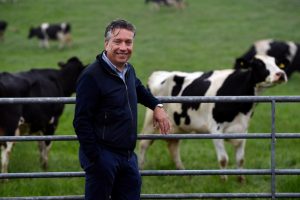
Don Morrow, Head of Dairying Development at CAFRE, introduced the event by stressing that farmers will have to adapt and change their business to make it more environmentally sustainable for the future. For example utilising manures more effectively and a more targeted use of feed and fertiliser, will not only bring environmental benefits but also financial dividends.
Neil Dyson, a dairy farmer from Buckinghamshire, spoke on the sustainability challenges that are facing him as an Arla supplier. Neil milks 450 summer calving cows on 300ha with an average milk yield of 9600 litres at 4.57% fat and 3.37% protein (794kg solids). He listed challenges such as higher energy and feed prices, reducing his carbon footprint and complying with the Clean Air and Water Act (soon be introduced in England). To meet this new legislation, farmers will be faced with increasing slurry storage requirements from five months to seven months and also reduce ammonia emissions. In relation to climate change, Neil is receiving a voluntary climate check bonus currently worth 0.9ppl to carbon footprint his farm and reduce it in the future. He is also receiving a voluntary cost compensation bonus worth 0.94ppl for meeting 26 metric targets such as mortality, lameness, mastitis, culling, etc.
Neil Dyson is also an Arla Innovation farmer which means his farm is used to trial new research projects. Currently he is trailing a N2 treatment plant, which reduces ammonia and methane from slurry and increases the nitrogen available in slurry three fold. This he hopes will contribute to reducing his carbon footprint and fertiliser bill. Another technology he is trialling is automated mobility and condition scoring using fixed cameras which monitor the cows as they leave the parlour. Neil remains positive about the future for dairy farming, as solutions will be found to sustainability issues with advances in technology.
Dr. Mark Little, nutritionist and veterinary adviser with Fane Valley, covered ways to combat antimicrobial resistance on farms, as overuse of them will lead to the build-up of resistance both in animals and humans. He give details of his Nuffield Scholarship looking at how good nutrition and management can reduce antibiotic use. He noted that, just by improving the environment for the animal, modifying its diet and the proper timing of vaccines, farmers can make a signiificant positive difference to herd health and therefore the need for antibiotic intervention. On his travels to the USA and various European countries, Mark explained the various tools which are being used to reduce antibiotic use, such as probiotics, prebiotics (encourage good gut bacteria), essential oils, plant extracts (anti-inflammatory/antioxidant properties) and bacteriophages (viruses that kill harmful bacteria).
In summary, Mark advised farmers to work with both their veterinary practitioner and nutritionist to draw up a herd health plan to provide the best possible environment for livestock to grow and perform with minimal use of antibiotics. To view this webinar, visit CAFRE TV on YouTube or the Dairy Business Support section of the CAFRE website www.cafre.ac.uk

























